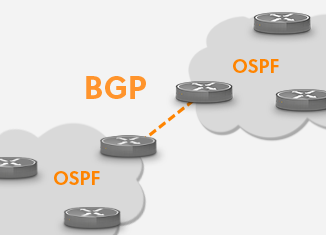References:
https://serverfault.com/questions/185635/what-is-the-difference-between-bgp-and-ospf
https://community.fs.com/blog/ospf-vs-bgp-routing-protocol-choice.html
https://techdifferences.com/difference-between-ospf-and-bgp.html
-----------------------------------------------------------------------------------------------------------------------
It will be worthwhile comparing two popular routing protocols widely used for making routing decisions across the internet.
BGP stands for Border Gateway Protocol
OSPF stands for Open shttps://techdifferences.com/difference-between-ospf-and-bgp.htmlhortest distance First.

BGP is exterior, OSPF is interior
OSPF is an intranetwork protocol which is used with in an AS(Autonomous System) while BGP is an inter network protocol and hence used between two different AS
If you are doing internal routing, i.e. routing within a site, company, or campus, you will want to use OSPF. Typically BGP is needed at a site edge, where you route out to the public internet. In small and medium size networks, static routes to the outside will usually be preferable to setting up BGP. If you have a complicated multi-homed site, regardless of size, you might consider BGP.

https://serverfault.com/questions/185635/what-is-the-difference-between-bgp-and-ospf
https://community.fs.com/blog/ospf-vs-bgp-routing-protocol-choice.html
https://techdifferences.com/difference-between-ospf-and-bgp.html
-----------------------------------------------------------------------------------------------------------------------
It will be worthwhile comparing two popular routing protocols widely used for making routing decisions across the internet.
BGP stands for Border Gateway Protocol
OSPF stands for Open shttps://techdifferences.com/difference-between-ospf-and-bgp.htmlhortest distance First.

BGP is exterior, OSPF is interior
OSPF is an intranetwork protocol which is used with in an AS(Autonomous System) while BGP is an inter network protocol and hence used between two different AS
If you are doing internal routing, i.e. routing within a site, company, or campus, you will want to use OSPF. Typically BGP is needed at a site edge, where you route out to the public internet. In small and medium size networks, static routes to the outside will usually be preferable to setting up BGP. If you have a complicated multi-homed site, regardless of size, you might consider BGP.

Here is a chart summarizing the differences of OSPF vs BGP:
| OSPF | BGP | |||||||||||
|---|---|---|---|---|---|---|---|---|---|---|---|---|
| Gateway Protocol | Internal gateway protocol | External gateway protocol | ||||||||||
| Implementation | Easy | Complex | ||||||||||
| Convergence | Fast | Slow | ||||||||||
| Design | Hierarchical network possible | Meshed | ||||||||||
| Need for device resources | Memory and CPU Intensive | Scaling is better in BGP although it relies on the size of the routing table | ||||||||||
| Size of the networks | Used on primarily smaller scale network which could be administered centrally | Mostly used on large scale networks such as the internet | ||||||||||
| Function | The fastest route is preferred over shortest | Best path is determined for the datagram | ||||||||||
| Algorithm Used | Dijkstra algorithm | Best path algorithm | ||||||||||
| Protocol | IP | TCP |
Implementation Easy Tough
Works on Protocol 89 179
Although BGP is used between multiple autonomous systems as an external
routing protocol, many network giants like Microsoft and Facebook would
use it internally – in this case, BGP is typically fit for very large
networks which OSPF fails to handle. One of the many reasons that BGP
does not function well as an internal gateway protocol is that it is
very slow to converge.
No comments:
Post a Comment